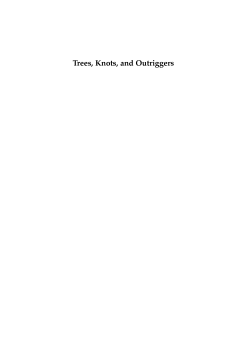
Additional Information
Book Details
Abstract
Trees, Knots and Outriggers (Kaynen Muyuw) is the culmination of twenty-five years of work by Frederick H. Damon and his attention to cultural adaptations to the environment in Melanesia. Damon details the intricacies of indigenous knowledge and practice in his sweeping synthesis of symbolic and structuralist anthropology with recent developments in historical ecology. This book is a long conversation between the author’s many Papua New Guinea informants, teachers and friends, and scientists in Australia, Europe and the United States, in which a spirit of adventure and discovery is palpable.
Frederick H. Damon is Professor of Anthropology at the University of Virginia.
“A masterpiece of engineering is notoriously difficult to write about, even more so when conceived and built by ‘visual and tactile people’. The author has succeeded well in giving the reader insight into the emic perspective of Muyuw canoes in all their social and ecological complexity. Herein lies the originality of this innovative and important work.” • Anthropos
“This book is a major contribution to the regional, ecological, and material culture literature.” • Pacific Affairs
“A rare and formidable work. This is a wholly distinctive contribution to multi-species ethnography, of environments made as people tie living materials to one another. It is also a wholly original account of the research process: had Damon not recorded the patchiness of knowledge – locally, regionally -- he would not have understood how people draw things together and keep them moving at the same time. String figures, he was told, untie the mind and keep it supple -- so does this energizing book.” • Marilyn Strathern, University of Cambridge
“This is a hugely important book. It’s publication marks a milestone in anthropological theory – a must read in any course concerned with material culture, science and technology, and human ecology, and a treasure for those interested in maritime cultures.” • Susanne Kuechler, University College London
“This research is a bold undertaking in its intention and in its attention to detail… this book leaves no stone unturned, no leaf unexamined, no canoe fixture unquestioned.” • Shirley Campbell, Australian National University
Table of Contents
| Section Title | Page | Action | Price |
|---|---|---|---|
| Contents | 7 | ||
| Figures, Graphs, Maps, and Tables | 8 | ||
| Acknowledgments | 10 | ||
| Part I — Among the Scientists: New Perspectives on the Massim | 15 | ||
| Introduction: Changes and Last Chapters | 17 | ||
| Chapter 1 — Return to the Garden: Gwed, Locating Intentions, and Interpretive Puzzles | 50 | ||
| Part II — Toward an Ethnography of Trees | 93 | ||
| Chapter 2 — The Trees: Classificatory Forms, Landscape Beacons, and Basic Categories | 95 | ||
| Chapter 3 — The Forest and Fire, Tasim, Inverted Landscapes, and Tree Meanings | 135 | ||
| Chapter 4 — A Story of Calophyllum: From Ecological to Social Facts | 194 | ||
| Part III — Synthesizing Models | 259 | ||
| Chapter 5 — Vatul: A Life Form and a Form for Life | 261 | ||
| Chapter 6 — Geometries of Motion: Trees and the Boats of the Eastern Kula Ring | 310 | ||
| References | 367 | ||
| Index | 378 |
